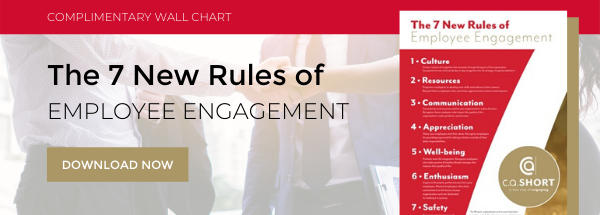5 Key Tactics to Achieve Enterprise Engagement

Have you noticed that many current reads, such as white papers, articles, and books, refer directly to emotion? It's not an accident; it's the framework of a movement regarding organizational employee engagement.You have probably come across terms like 'emotional paycheck', engagement, emotional bonding, and the importance of incorporating them into the workplace. The concept is pretty cut and dry - make a conscious effort to support, recognize, and encourage your employees, which will in turn translate to increased business outcomes. What is not as cut and dry is developing the intricacies of the engagement strategy. This is where the idea of Enterprise Engagement comes into play.
What is Enterprise Engagement?
In my readings, I came across Enterprise Engagement: The Textbook, which has been an eye-opening read, both personally, and for our operations at C.A. Short Company has a whole. If you're new to the principles of Enterprise Engagement, it's the idea that by proactively involving all facets of your organization (or enterprise) into your engagement strategy, you are able to foster results and achieve your organizational goals.
Beginning an Enterprise Engagement Strategy

Much like any new project implementation, a solidly constructed strategy is going to be the key to success. Cultural preparedness, management sponsorship, engagement benchmarking & measurement strategies and an exhaustive engagement communication plan are must haves when incorporating the principles of Enterprise Engagement into an engagement plan.
No one said this was going to be easy, but we know that organizations who apply the Enterprise Engagement principles consistently outperform their competitors in earnings and growth. In reality, how can any organization ignore the movement of Total Enterprise Engagement?
According to Enterprise Engagement: The Textbook, there are 5 Key Tactics to ensure support and follow-through of your Enterprise Engagement strategy:
- The Right Message: You have to build a level of trust with your employees. Communication is key and needs to be consistent and constant. Be honest and transparent. Share the background of why the employee engagement strategy was developed, how the leadership team formed the strategy, and how it will benefit the employees.
- The Right Team: In order to seamlessly transition from the planning to the implementation stage, key stakeholders must be involved throughout the entire process. As your engagement program progresses, your team will undoubtedly grow to include each segment of involved engagement. It’s important to give these teams ownership and responsibility for the results.
- The Right Skills: Whether it’s your customer service specialist, sales managers, or procurement team, in order to facilitate Enterprise Engagement successfully, the key players of each segment will need comprehensive resources and training to carry out the plan to all aspects of the business.
- The Right Goals: It is important to set realistic and measurable goals.You want your goals to be attainable, but you want your people to push themselves to achieve more than merely the status quo. Setting benchmarks and performing a regular SWOT analysis will help gauge the progress of your new initiatives. As with all goal-based strategies, goals must be evaluated and refined on an ongoing basis.
- The Right Incentives: The success of your strategy will rely on the incentives offered to employees for modifying their behaviors. It’s important to reward good behavior while curbing undesirable or bad behavior. This applies not only to your workers, but to the total core team responsible for implementing the engagement strategy. Making recognition a priority engrains Enterprise Engagement at your organization’s core – It’s culture.
Once you have the strategic foundation, the plan, and the executive level buy-in, how do you engage your workforce to embrace the change?
Implementation of a Total Enterprise Engagement strategy is a mindset and is a series of practices and protocols, which requires a significant change in organizational culture and values. Is it a process and a comprehensive journey? Absolutely, but the Enterprise Engagement is worth the investment of building an engaged company culture.
At C. A. Short, we are your partner for increased employee engagement resulting in increased performance outcomes to grow your bottom line. Our process and research-based platform help you engage your team in order to increase your bottom line, motivate your staff to the benefit of the entire organization and reward your people for the positive changes they make. To request a Complimentary Consultation, please click here.
